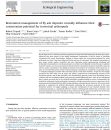Bibliografie
In search for a compromise between biodiversity conservation and human health protection in restoration of fly ash deposits: effect of anti-dust treatments on five groups of arthropods. 2015
- Autoři
- Mgr. Igor Malenovský, Ph.D., Jakub Straka, RNDr. Robert Tropek, Ph.D.
- Abstrakt
- Recently, fly ash deposits have been revealed as a secondary refuge of critically endangered arthropods specialised on aeolian sands in Central Europe. Simultaneously, these anthropogenic habitats are well known for their negative impact on human health and the surrounding environment. The overwhelming majority of these risks are caused by wind erosion, the substantial decreasing of which is thus necessary. But, any effects of anti-dust treatments on endangered arthropods have never been studied. We surveyed communities of five arthropod groups (wild bees and wasps, leafhoppers, spiders, hoverflies and orthopteroid insects) colonising three fly ash deposits in the western Czech Republic. We focused on two different anti-dust treatments (~70 and 100 % cover of fly ash by barren soil) and their comparison with a control of bare fly ash. Altogether, we recorded 495 species, including 132 nationally threatened species (eight of them were considered to be extinct in the country) and/or 30 species strictly specialised to drift sands. Bees and wasps and leafhoppers contained the overwhelming majority of species of the highest conservation interest; a few other important records were also in spiders and orthopteroids. Total soil cover depleted the unique environment of fly ash and thus destroyed the high conservation potential of the deposits. On the other hand, partial coverage (with ~30%of bare fly ash) still offered habitats for many of the most threatened species, as we showed by both regression and multivariate analyses, with a decrease of wind erosion. This topic still needs much more research interest, but we consider mosaic-like preservation of smaller spots of fly ash as one of the possible compromises between biodiversity and human health.
Restoration management of fly ash deposits crucially influence their conservation potential for terrestrial arthropods. 2014
- Autoři
- Jakub Straka, RNDr. Pavel Pech, Ph.D., RNDr. Robert Tropek, Ph.D.
Statistiky
Nalezeno
262
Nálezy
110
Druhy
75
Rody
6
Čtverce




